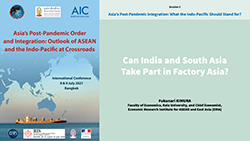Chinese Perspectives of the Indo-Pacific Concept and Major Power Relations / HOO Tiang Boon

Chinese Perspectives of the Indo-Pacific Concept and Major Power Relations
HOO Tiang Boon, RSIS, Singapore
In recent years there have been growing attention on, and increasing usage of, the term “Indo-Pacific” to characterize the political geography of the Asia-Pacific region. While the concept itself is not new and has multiple origins, it gained new levels of prominence when Washington began to evoke the parlance in its policy documents and rhetoric from around 2017. American employment (...)



















